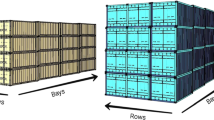Abstract
The planning, design and development of a container terminal with optimum size and capacity and with a minimum capital cost is fundamentally dependent upon the loading and discharging operations at the quayside. Achieving this purpose, terminal operators have to choose the best operating system in the container yard. The decision on which equipment is used at container terminals depends on several factors. The purpose of this study is to provide a new decision making tool using the first law of thermodynamics. It considers a port as a control volume of a fluid system and models the port and its traffic on it. The results of this study evaluate container yard operating systems and set up a basis for decision making to select the best alternatives.
Similar content being viewed by others
References
Annamalai, K. and I. Puri. 2001.Advanced Thermodynamics Engineering. Boca Raton, Leiden, Abingdon: CRC Press.
Bish, E.K. 2003. A Multiple-Crane-Constrained Scheduling Problem in a Container Terminal.European Journal of Operational Research 144: 83–107.
Bruzzone, A., P. Giribone, and R. Revertria. 1999. Operative Requirements and Advances for the New Generation Simulators in Multimodal Container Terminals. In1999 Winter Simulation Conference Proceedings, Vol. 2, ed. P. Farrington, H.B. Nembhard, D. Sturrock, Gerald W. Evans, 1243–1252. Piscataway: IEEE.
Cengel, Y.A. and M.A. Boles. 2006.Thermodynamics: An Engineering Approach. 5th ed. Boston: McGraw-Hill.
Journal of Containerisation International. 1996. Market Analysis in Terminal Handling Equipment. April.
Khoshnevis, B., and A. Asef-Vaziri. 2000. 3D Virtual and Physical Simulation of Automated Container Terminal and Analysis of Impact on In Land Transportation. METRANS Transportation Centre, University of Southern California. http://www. metrans.org/research/final/99-14_Final.pdf (accessed October 1, 2009).
Kiani, M. 2007. The Impact of the Automation on the Efficiency and Cost Effectiveness of the Quayside and Container Yard Cranes and the Selection Decision for the Yard Operating Systems. PhD thesis, School of Engineering, Liverpool John Moores University.
-. 2008. Multiple Attribute Decision Making (MADM) and Analytical Hierarchy Process (AHP) for Selecting a Container Yard Operating System. Paper presented at the International Conference on Transit and East Corridor Development, Tehran, Iran.
Kiani, M., S. Bonsall, J. Wang, and A. Wall. 2006. An Experimental Evaluation of the Economic Feasibility of Automated Quayside Cranes.Maritime Technology Society Journal 40: 51–61.
Kiani, M., A.S. Nooramin, and A. Pakdin. 2008. Formulating a Break-Even Model for Evaluating the Cost of Container Vessels Waiting Times and Berth Idle Times in Automated Quayside Operation. Paper presented at the 10th Conference on Marine Industries, Abadan, Iran.
Kim, K.H., and H.B. Kim. 1998. The Optimal Determination of the Space Requirement and the Number of Transfer Cranes for Import Containers.Computer and Industrial Engineering 35: 427–430.
—. 2002. The Optimal Sizing of the Storage Space and Handling Facilities for Import Containers.Transportation Research B 36: 821–835.
Kozan, E. 1997. Increasing the Operational Efficiency of Container Terminals in Australia.Journal of the Operational Research Society 48, 151–161.
—. 2000. Optimizing Container Transfers at Multimodal Terminals.Mathematical and Computer Modelling 31: 235–243.
Linder, B. 2004.Thermodynamics and Introductory Statistical Mechanics. Hoboken, NJ: John Wiley & Sons, Inc.
Nam, K.C., and W.K. Ha. 2001. Evaluation of Handling Systems for Container Terminals.Journal of Waterways, Port, Coastal and Ocean Engineering 127: 171–175.
Saanen, Y 2000. Examining the Potential for Adopting Simulation Software to Enable Short-Term Tactical Decision Making for Operational Optimization. Technical Report. TBA Netherland/Delft University of Technology.
Saanen, Y., J. van Meel, and A. Verbraeck. 2003. The Next Generation Automated Container Terminals. Technical Report. TBA Netherland/Delft University of Technology.
Steenken, D., S. Vob, and R. Stahlbock. 2004. Container Terminal Operation and Operations Research —A Classification and Literature Review.OR Spectrum 26: 3–49.
Van Asperen, E., R. Dekker, M. Polman, and A. Swaan. 2003. Modeling Ship Arrivals in Ports. InProceedings of the Winter Simulation Conference 2003, ed. S. Chick, P. J. Sánchez, D. Ferrin, and D. J. Morrice, 1737–1744. New Orleans: Omnipress.
Watanabe, I. 2001.Container Terminal Planning — a Theoretical Approach. Leatherhead: World Cargo News.
Author information
Authors and Affiliations
Rights and permissions
About this article
Cite this article
Nooramin, A.S., Kiani, M. An energy-cost approach for evaluation of operating systems in container terminals. WMU J Marit Affairs 8, 203–213 (2009). https://doi.org/10.1007/BF03195160
Issue Date:
DOI: https://doi.org/10.1007/BF03195160




